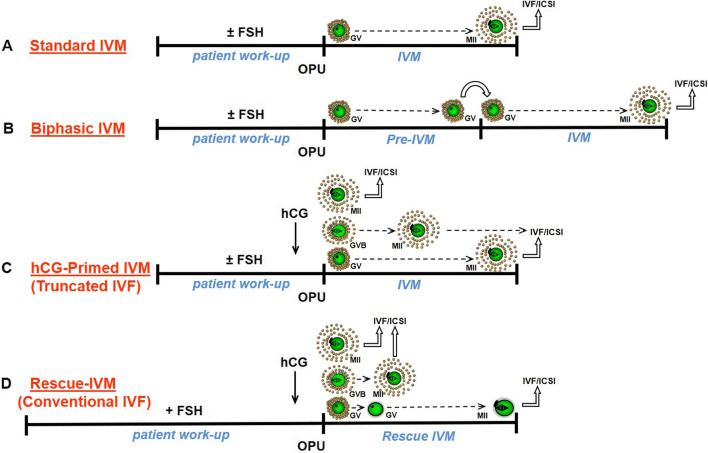Fig. 4.
Major IVM protocols. A The original IVM protocol [8], where immature, GV-stage COCs are matured in vitro in one step to MII. Patients may or may not receive prior FSH priming as in either case all oocytes are at the GV stage at OPU. B A biphasic IVM protocol is a small variation on standard IVM, the notable difference being the additional pre-IVM culture step. Here, meiosis of immature cumulus-enclosed oocytes is deliberately arrested for ~ 24 h, before moving COCs into a meiosis promoting medium. Examples include the SPOM- and CAPA-IVM protocols. Patients may receive prior FSH priming, but not hCG priming, as the latter is incompatible with the need for intact compact COCs in this platform. C Patients receive a bolus of hCG prior to OPU, +/− prior FSH priming. A proportion (~ 10–20%) of oocytes are collected at the MII stage, some resume meiosis in vivo but are not mature (germinal vesicle breakdown (GVB) or MI), and the majority of oocytes are at the GV stage. The different stages of meiosis at OPU necessitate differing treatment in the laboratory: MII require fertilization on the day of OPU, whereas the maturing and immature oocytes require IVM culture. D This is the maturation in vitro of immature GV-stage oocytes collected from conventional IVF cycles after OS and ovulation triggering, mostly with hCG [38]. These are commonly regarded as medically unusable oocytes and are usually discarded in most IVF clinics [39]. These oocytes are usually naked, as oocytes are denuded of cumulus cells after OPU prior to ICSI; hence, rescue IVM oocytes are invariably cultured in a denuded state from the GV to MII stage in vitro

